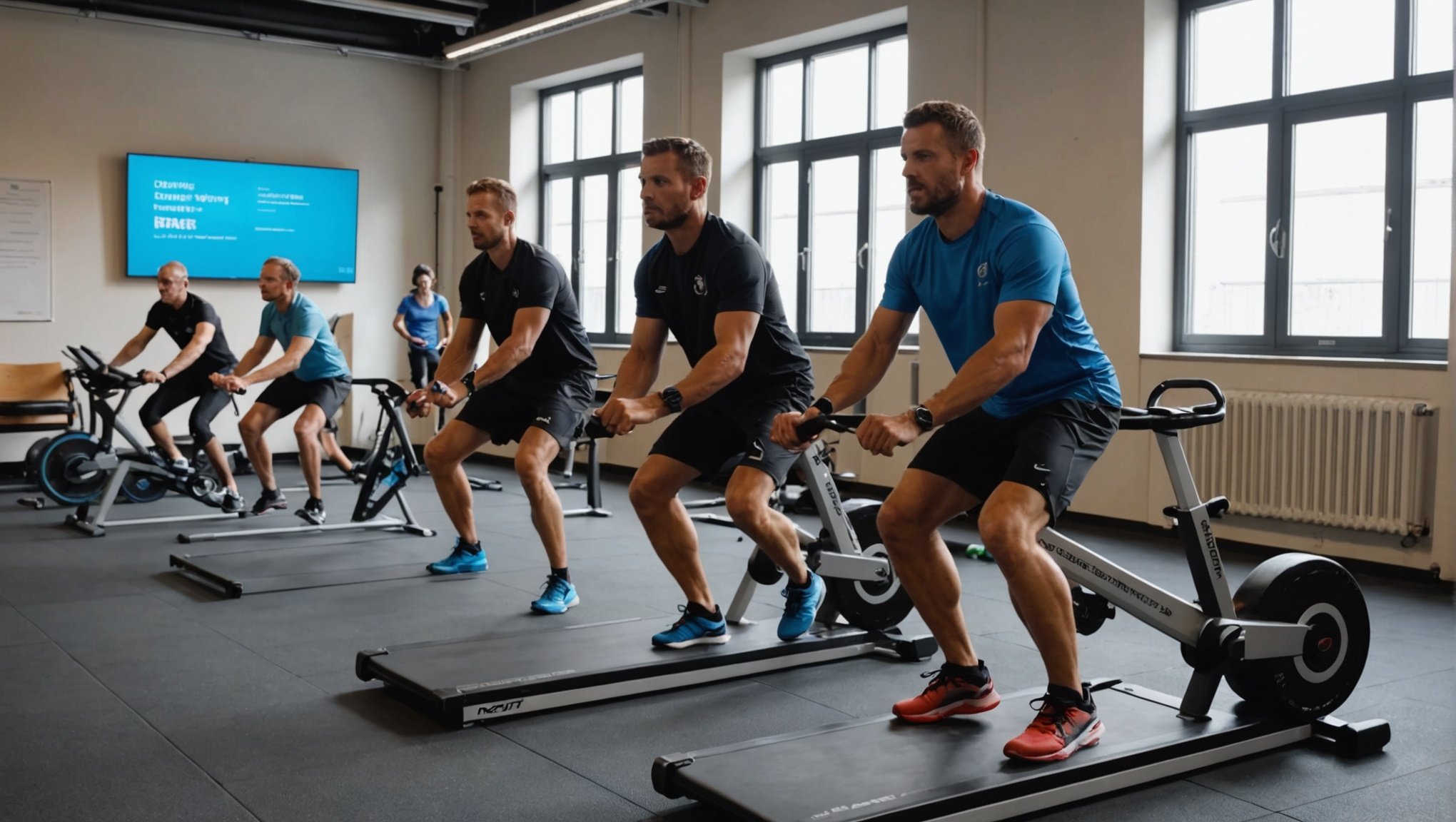Virtual Team-Building Activities Overview
In today’s increasingly digital workplace, the importance of team cohesion for remote teams cannot be overstated. Virtual team-building activities are crucial in fostering unity, especially when team members are athletes separated by distance. These activities not only enhance trust but also improve communication among team members.
There are several remote training exercises that athletes can engage in to promote collaboration. For example, virtual scavenger hunts can encourage creativity and quick-thinking, while online strategy games can enhance problem-solving skills and cooperation. Video call workouts also offer an opportunity for athletes to maintain fitness levels while bonding with teammates. Additionally, hosting virtual challenges or competitions can foster friendly rivalry and motivate team members to strive for collective success.
Additional reading : Unlocking Peak Performance: How Psychological Strategies Can Alleviate Gymnastics Competition Anxiety
The numerous benefits of engaging in virtual team-building activities include improved morale and a stronger sense of belonging among athletes. These exercises help break down geographical barriers, allowing for diverse perspectives and strategies to be shared effortlessly. By participating in such activities, athletes can develop a deeper understanding of their team’s dynamics and strengthen their overall performance. It is through these shared experiences that athletes can build a resilient, supportive team environment, essential for any successful remote collaboration.
Innovative Exercises for Enhancing Team Unity
Incorporating virtual exercises into your team’s routine can enhance engagement and strengthen bonds. Innovative virtual exercises, such as structured workout circuits, are effective strategies for maintaining teamwork and athlete engagement.
In the same genre : How Virtual Fans Transform the Vibe of Empty Sports Arenas
Virtual Workout Circuits
Structured workout circuits can be adapted to cater to different sports, ensuring inclusivity and engagement. For instance, you can design sport-specific exercises that hone essential skills while promoting cardiovascular fitness. Monitor improvements by establishing benchmarks, and maintain team accountability by sharing results through virtual platforms. Consistent tracking keeps athletes motivated and unified.
Online Strategy Sessions
Utilize video calls to host strategy discussions, fostering open communication. Use tools like digital whiteboards or shared documents for effective brainstorming. Encourage input from all team members, ensuring varied perspectives are considered and included in planning sessions. This inclusive approach not only improves strategies but also reinforces team cohesion.
Collaborative Goal Setting
Virtual platforms enable efficient goal-setting sessions, aiding both individual and team growth. Set measurable milestones and track progress using shared documents or dedicated apps. Celebrate achievements remotely through digital shout-outs or virtual celebrations to maintain high morale. Collaborative efforts enhance commitment and foster a sense of collective success within the team.
Practical Implementation Tips
In the age of remote work, mastering remote training strategies is essential. Selecting the appropriate technology and platforms for virtual exercises is the first step toward success. Platforms like Zoom or Microsoft Teams offer robust features for interactive sessions, making them ideal for virtual exercise facilitation. Ensure the platform supports breakout rooms for small group discussions and integrates with tools for sharing presentations and resources.
Effective team management hinges on strategic scheduling and time management. Consistency is key; plan sessions at regular intervals and consider time zone differences to accommodate all team members. Tools like Google Calendar or Doodle can aid in finding suitable times for everyone. Keep sessions concise to maintain focus and prevent fatigue.
To foster participation and engagement, encourage open dialogue and use interactive elements like polls and Q&A sessions. Tools like Mentimeter or Kahoot make it easy to incorporate engaging activities. Encouraging video participation can create a more personal connection, addressing the potential isolation of remote settings.
Empathy in communication and frequent feedback help build a supportive environment, enhancing both engagement and learning outcomes. With these strategies, remote training can become a seamless and effective part of your team’s workflow.
Success Stories and Testimonials
Understanding how remote training impacts performance and unity can offer valuable insights into team success stories. Several teams have demonstrated remarkable improvements, thanks to their dedication to virtual exercises. These exercises fostered a unified approach, breaking geographical barriers and enhancing communication. By adopting innovative strategies, such as real-time video collaborations and feedback systems, these teams managed to maintain a high level of cohesion. The key takeaway here is the importance of continuously engaging with each team member to ensure everyone moves toward common goals.
Case Studies of Successful Teams
One notable example includes a basketball team that successfully leveraged virtual platforms to enhance their on-court performance. They meticulously scheduled remote sessions focusing on skill drills and strategy discussions, which translated into an improved game performance. The team’s success can largely be attributed to their focus on maintaining solid communication throughout the training process.
Testimonials from Athletes
Athletes have been vocal about the benefits of remote training on their mindset and performance. A seasoned swimmer noted how virtual check-ins with teammates kept her motivated and accountable. She highlighted that consistent collaborations significantly boosted morale. Such testimonials underline the importance of unity, emphasizing that the sense of belonging and shared goals can significantly enhance sporting experiences.
Adapting Exercises for Different Sports
When considering sport-specific adaptations, one must ensure exercises are properly tailored to meet the unique needs of each athletic discipline. This involves customizing training programmes to enhance performance and prevent injuries in specific sports. For instance, virtual exercises for a basketball player might focus on agility and vertical jump enhancement, whereas a swimmer could benefit from workouts targeting endurance and arm strength.
In accommodating various skill levels in a virtual setting, it is crucial to offer modifications for beginners while also challenging advanced athletes. This enables all participants to engage fully and progress at their own pace. Adaptive tools and digital platforms can adjust the intensity and complexity of exercises, making training accessible and effective for everyone, regardless of their initial capability.
Athlete inclusivity is another pivotal aspect. Coaches and trainers should embrace the diversity of athletes’ backgrounds, ensuring that training routines are culturally considerate and physically achievable for all. This might involve utilising multilingual instruction materials or creating alternative exercises for those with disabilities. By focusing on these facets, athletes feel valued and supported, promoting a positive and inclusive training environment. Similarly, fostering an atmosphere of cooperation and respect encourages comprehensive athletic development.
Tools and Platforms for Virtual Team-Building
Navigating virtual team-building requires the right technology for remote collaboration. This section explores the tools and resources to enhance team effectiveness and communication, especially within sports and athletic environments.
Overview of Recommended Platforms
Choosing between platforms like Zoom, Teams, and Slack can impact virtual teamwork significantly. These tools facilitate seamless communication and integration for team activities. Zoom offers robust video conferencing ideal for webinars and virtual meet-ups, allowing clear and interactive sessions. Teams integrate well with Microsoft services, providing a broad suite of features, including file sharing and joint document editing. Slack, known for its swift team communication, supports real-time messaging, enabling quick decision-making.
Evaluating team communication tools requires considering the specific needs of your athletes. Zoom is beneficial for live video instructions, Teams for creating detailed schedules, and Slack for maintaining conversational threads. Assess these platforms against your team’s demands to maximise productivity.
Resources for Creating Engaging Content
Engaging virtual training involves online training resources that inspire creativity. Look for exercise ideas on platforms like YouTube for varied exercise formats. Sharing multimedia content, such as instructional videos and interactive sessions, can make training dynamic. Innovate by mixing traditional exercises with fun, online challenges. Keep your team excited and engaged with diverse, fresh activities utilising online resources consistently.










